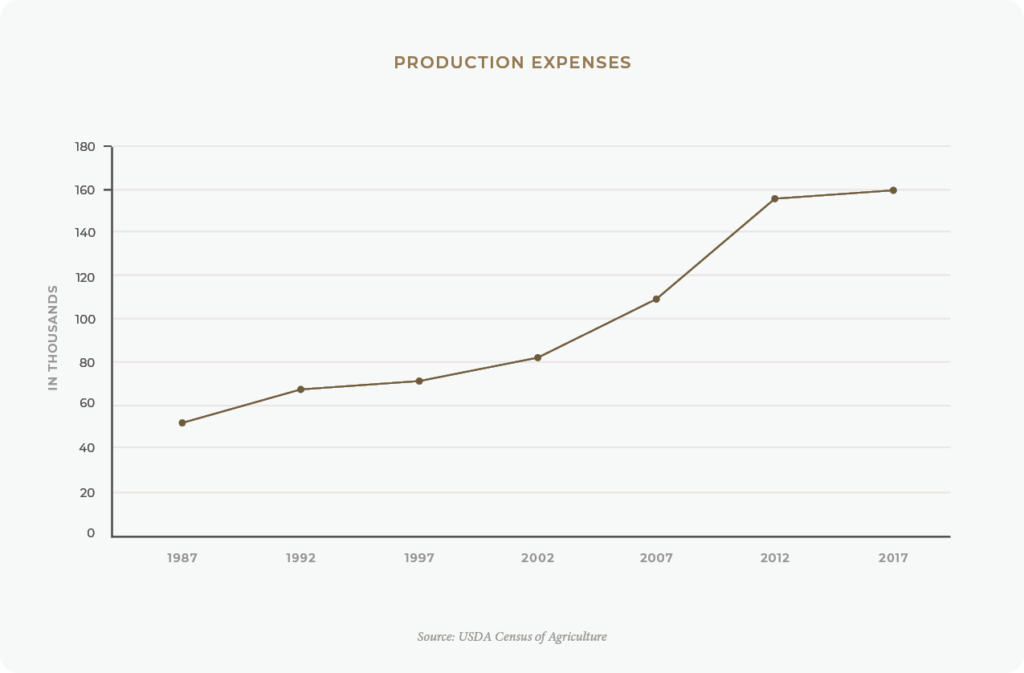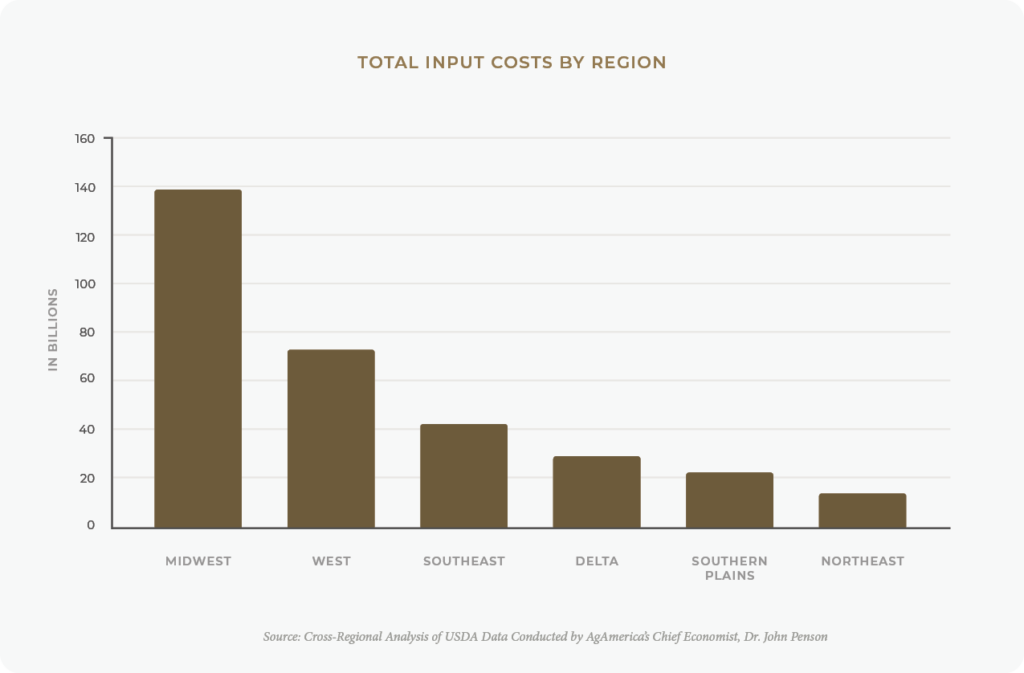Reduce Farm Input Costs: Farm Financing Options
Amid a strong market, farm input costs are rising.
While the agricultural market is currently experiencing stronger prices across the board for the first time in years, input costs are rising and shrinking the profit margins of American farmers. According to the USDA 2017 Census of Agriculture, total farm production expenses are more than $326 billion. To illustrate the scope of this issue, according to the USDA 2017 Census of Agriculture, average production expenses per farm increased from $155,947 in 2012 to $159,821 in 2017. These rising input costs impact farmers in a highly personal way. When it costs more to keep their operation going, they end up spending a larger share of their working capital on input costs while experiencing a lower profit.

In this article, you will learn more about:
- The distribution of farm operational expenses;
- The factors contributing to rising farm input costs;
- The regional variation of farm input costs; and
- Strategies to reduce farm input costs.
The Distribution of Farm Operational Expenses
Many input costs go into supporting a successful farm operation. The top five farm production expenses, according to the USDA 2017 Census of Agriculture, include:
- Livestock feed: 19.2 percent;
- Leased or purchased livestock and poultry: 13.8 percent;
- Hired farm labor: 9.7 percent;
- Fertilizer, lime, and soil conditioners: 7.2 percent; and
- Cash rent for land, buildings, and grazing facilities: 6.5 percent.
*Percentages represent percent of total farm production expenses.
Factors Contributing to Rising Farm Input Costs
Along with increasing farm input costs, commodity prices for corn and soybeans are also increasing. While positive for many farmers, this means higher input costs for cattle ranchers. In addition, widespread supply shortages in microchips, plastic wrap, and fertilizers have increased operational expenses. Finally, logistical difficulties have increased the prices of transportation. All of these factors have contributed to the rise in expenses.
The increase in commodity prices has unintended consequences that affect operations differently. For instance, an operation that purchases these commodities to sustain their operation would be affected differently than an operation that sells these commodities. Therefore, it is important to understand the multifaceted nature of rising prices.
Regional Variation of Farm Input Costs
While the increase in input costs is a nationwide phenomenon, regional data attests to how much farming can vary from region to region. In a recent analysis of USDA data conducted by AgAmerica’s Chief Economist Dr. John Penson, several regional differences were uncovered regarding input expenses:
- The Midwest has both the highest input costs and agricultural production.
- The Midwest has the highest product expenses at $108,094,153,000.
- The West has the highest labor expenses at $4,964,388,000.
The following chart demonstrates how total farm input costs vary by region.

Strategies to Reduce Farm Input Costs
While rising input costs certainly pose a significant challenge for farmers, there are ways to mitigate their negative effects.
Monitor Key Performance Indicators
It is important to thoroughly monitor operational performance and consider key performance indicators (KPIs). Measuring these indicators aids in reducing farm input costs by providing quantitative measurements that indicate financial health and areas for improvement. In doing so, keeping track of KPIs contributes to increased yields and lower input costs.
The top five KPIs to keep track of include:
- Commodity pricing;
- Working capital;
- Debt-to-asset ratio;
- Asset turnover ratio; and
- Price of goods in region.
Especially important in this discussion of input costs, the asset turnover ratio measures how efficiently your assets are generating value. The higher the asset turnover ratio, the more efficiently you are utilizing your resources.
Smart Investing in Cost-Saving Methods
Investing in precision ag tech and efficient farm equipment is another way to reduce operational costs. Smart investment decisions can both decrease costs and increase yields over time. As a result, the operation becomes more resilient to unpredictability. In fact, farmers who use precision ag technology have increased their corn yields by 11 percent while reducing their operational expenses by 9 percent.
Note: Before investing, it is important to ensure that your ROI is still at an appropriate level. In broader terms, strategic investing and careful consideration are essential before deciding to invest.
Examples of cost-saving farm investments include:
- Drip irrigation systems;
- Legume planting to reduce fertilizer costs for corn growing;
- Integrated pest management techniques to manage pests;
- Smart cloud databases; and
- AI technology.
Develop a Vertically Integrated Operation
Vertical integration is an immensely powerful technique that allows farmers to control the factors of production on their operations. This allows them to reduce their operational expenses. For example, many cattle ranchers grow their own feed to secure wholesale prices. This also creates an opportunity for additional revenue streams if they begin supplying feed for others.
Vertically Integrated Farm Increases Working Capital with AgAmerica’s Flexible Financing
To mitigate risk and increase profit margins, a multigenerational farm operation in New Mexico developed into a vertically integrated operation. This means that they planted, harvested, and packaged their goods shipped nationwide. To further support the success and longevity of their family operation, AgAmerica refinanced their existing debt obligations along with providing a revolving line of credit for operational expenses. This provided the family with access to working capital while also providing more resources to invest back into their operation.
Increase Your Working Capital with AgAmerica
American farmers and ranchers nationwide have unique challenges and needs that require individual solutions. AgAmerica’s flexible financing options allows you to invest in your operation’s long-term success. You deserve to make the right decisions for your operation. That’s why we provide the financial freedom to help you build a resilient and profitable operation.
Explore the ways AgAmerica can boost your working capital to support the long-term success of your farm.






